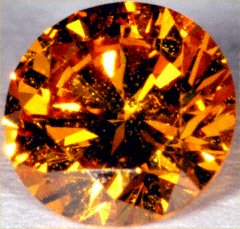| The Very Highest Quality Diamond Information... |
| Diamonds - Beyond The 4 C's - Created |
|
|

|
|
|
Synthetic = Real
Many people think the word synthetic means fake, "not real", man made or "not natural". Strangely enough there are some of its dictionary definitions, but the word synthesis actually means put together or assembled. Green plants, for example synthesize chlorophyll. The chlorophyll they produce is genuine, real, natural. and not man made. So in its most pure sense, the word synthetic means put together. assembled, or created. It does not mean unreal.
Synthetic Diamonds Are Real Diamonds
It follows from the above that synthetic diamonds are real diamonds. They are made from carbon, exactly the same as natural diamonds. Currently it is possible to distinguish natural from synthetic diamonds, mainly as a result of different types of inclusions, but at some time in the future it may be possible to create undetectable synthetic diamonds.
Synthetic Versus Simulant
A diamond simulant, sometimes misleadingly called a simulated diamond is not the real thing. A simulant is an imitation. Examples of diamond simulants include glass, sometimes called paste, white sapphire, white spinel, YAG (Yttrium Aluminium Garnet), moissanite, and cubic zirconia.
More About Synthetic Diamonds
We will hear much more about synthetic diamonds in the next few years. A number of different companies are already producing gem quality diamonds, and these are appearing on the market already. We have had some in stock for over a year now, one of which we show in our photograph. As you will notice it appears orange, although some would describe it as yellow. It is quite difficult to get an accurate rendition of its colour in a photograph. We also have them available for sale.
Coloured or White?
Really our question should be coloured or colourless. Almost all of the synthetic diamonds produced until very recently were yellow. In the last few years, we are hearing increasing reports and rumours that synthetic white diamonds have been or are being produced. This will happen eventually, although it seems to be taking longer than many people have been predicting. Because most of the diamonds sold for jewellery are white or at least whiteish, we expect this will cause practical problems identifying them, especially in the second-hand marketplace.
The Future for Natural Diamonds
There are always doom-mongers who claim that once man can create synthetic real diamonds commercially, that this will cause the market for natural diamonds to collapse. Although the availability of a choice must lead to some change, we believe a market collapse to be extremely unlikely. As examples, there have been synthetic real rubies, sapphires or emeralds for about 100 years, yet most people still buy and prefer the natural item. Also when cultured pearls were introduced, many claimed that the market for natural pearls would disappear. Natural pearls still bring high prices, especially large and better quality ones, although most women buying or wearing pearls now consider cultured pearls to be the "real thing". Simulated pearls look and feel cheap and nasty in comparison. The market for cultured pearls has grown, but the market for naturals still exists.
Testing, Testing...
In the 1990's, our company all but stopped having our diamonds graded and certificated by gem laboratories. We had been one of the few jewellers in the UK to have sold certificated diamonds. After the internet took off, we restarted selling certified stones, because public awareness and education, via the web, meant customers had started to ask us for certificated stones. As often, we had been too far ahead of the market. In future, a higher proportion of all diamonds will be certificated, and this will enable synthetic diamonds to be identified. It is also likely that specialised equipment for detecting synthetics will become available at commercial prices. Currently such equipment is very expensive to buy and operate. Larger and better quality diamonds will almost automatically be certificated. The only sector of the diamond market which may be greatly infiltrated and undermined by synthetic diamonds will be for smaller and cheaper (lower grade) ones. As these are not purchased as investments, then there should be no real problem.
Created Diamonds For Sale
A short stocklist of created (synthetic) diamonds for sale.
Diamond Glossary - An A to Z of Diamonds
| ...at the Lowest Possible Price |
|
32 - 36 Harrowside, Blackpool, Lancashire, FY4 1RJ, England. Telephone (44) - (0) 1253 - 343081 ; Fax 408058; E-mail: The URL for our main page is: https://24carat.co.uk | Chard(1964) Ltd |